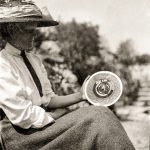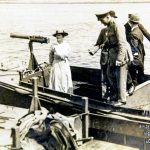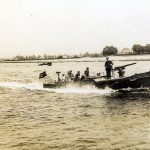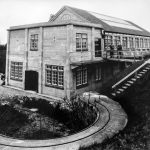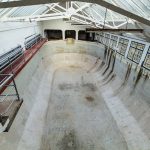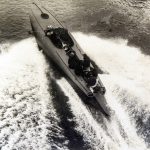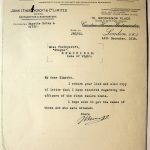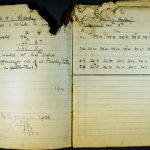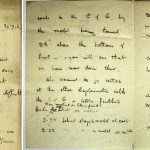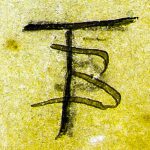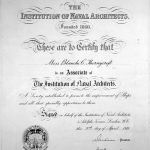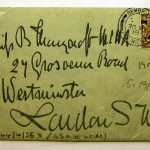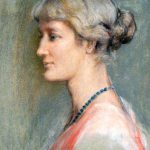Engineering and the family in business: Blanche Coules Thornycroft, naval architecture and engineering design
Article DOI: https://dx.doi.org/10.15180/1851009
Abstract
This paper seeks to examine and contextualise the role of Blanche Thornycroft within her family business of John I. Thornycroft in the first half of the twentieth century. The role of Blanche in assisting her father and, after his death, the Thornycroft Company in collecting experimental data informed the design of many vessels. Her role in testing Coastal Motor Boats is explored using the archival material discovered during the ARHC funded project ‘Business, government and the workplace: John I. Thornycroft & Company Limited, and the Great War’.
Keywords
design, engineering, family business, ship, testing tank, Thornycroft, Women
Introduction
https://dx.doi.org/10.15180/The gradual acceptance of women into a profession which might previously have been regarded as a bastion of male knowledge and practice has long been of interest to scholars of both gender and engineering. Wightman’s analysis of engineering in the workplace is a good example (Wightman, 2010).
The larger question of the role of gender within the context of the development of family businesses generally has become the subject of academic enquiry over a range of countries, timespans and family relationships since the late 1980s, though in comparison with the literature on business in the wider context it is still somewhat sparse. Lyman et al (Lyman, 1985, pp 303–324) makes the point that, historically, the focus of the business has been the male founder and his heirs, noting that, ‘The strength of traditional family roles, both within society and within individual families, kept women’s contributions from being acknowledged’. However, Rodríguez-Modroño et al (Rodríguez-Modroño, Lina Gálvez-Muñoz and Astrid Agenjo-Calderón, 2015, p 2) begin from the point ‘…that women have historically played an important “hidden” role in family firms, a role that is being highlighted now by numerous studies[1] within the fields of economic and business history’. This paper will show that whilst Blanche remained largely geographically isolated from the shipbuilding plant, the archival evidence points clearly to her role in research and development for the company.
For the British economy this is especially important because of the alleged role of family business in British management. Alfred Chandler’s analysis of Germany, the United States and Britain condemned the role of British families in failing to modernise effectively (Chandler, 1990). The Chandlerian approach to business history in general and British business history in particular has been modified considerably in the last decade or so (Hannah, 2009). This paper explores in more depth the relationship between family members and business operations within the family enterprise revealing how effective kinship was in developing new products. Blanche’s Associate Membership of the Institution of Naval Architects attests to her specific contribution to the company’s product range and her personal engineering knowledge, suggesting that she was a pioneer in professional engineering.
This paper explores the role of Blanche Thornycroft in the company and the importance of her work in creating new ships using experimental data. The evidence presented here has been drawn from the Thornycroft archives which are split between Southampton Record Office and Winchester Archives held at The Hampshire Cultural Trust, Chilcombe. In addition, we have been fortunate that the Classic Boat Museum at East Cowes holds some of Blanche’s notebooks and the ship tank models used in the engineering calculations. Written in monographed school note books, Blanche’s test notes held by the Classic Boat Museum, begin in 1907 and continue until 1939. Also present is a bound book which contains curves and calculations of ‘Velocity and Weight per BHP’ for various vessels in what appears to be Blanche’s handwriting. These materials suggest that Blanche did calculations and recorded tests on all the models tested in the lily pond at the family home and later at the Bembridge Tank. These included the racing motor boats, called Skimmers, which developed into Coastal Motor Boats, Acasta and Acheron Class Destroyers for the Royal Navy, motor torpedo boats, Royal Air Force Rescue Launches, and RNLI Lifeboats.
This paper begins with a review of the Thornycroft company and the origins of ship testing in Britain before going on to discuss the development of boats, and in particular Coastal Motor Boats (CMBs) during the First World War. It then considers the Blanche’s contemporaries to contextualise her role in the wider engineering and business community before examining her own achievements.
The Thornycroft company
https://dx.doi.org/10.15180/1851009/002John Isaac Thornycroft founded the shipbuilding company of John I. Thornycroft and Company on the River Thames at Chiswick in 1866, though he is recorded as having built steam launches in the same yard as early as 1864. The company later diversified into road vehicles with an extra factory site at Basingstoke where steam, paraffin and, later, petrol lorries were constructed. Perhaps the most famous of these was the ‘J type’ lorry used extensively during the First World War, both at home and on the western front.
In the latter years of the nineteenth century the size of vessels required by the Navy grew to the point at which, if they were launched at Chiswick parts of the superstructure had to be removed in order to allow them to pass under the relatively low bridges on the Thames to sail on trials. Hence in 1904 the Thornycroft Company purchased a ship yard at Woolston, Southampton and its future shipbuilding was largely based here. It is interesting that at this point the testing tank was constructed at the family home rather than the works. It is perhaps indicative of where Thornycroft wanted to work on a day-to day basis, although it could also reflect site restrictions at Woolston; the lack of evidence here means that one can only speculate. To explore the role played by Blanche in the family business we need to understand the context within which ship testing was carried out both within the company and more widely at the time.
The origins of ship testing in Britain
https://dx.doi.org/10.15180/1851009/003The move from empirical rule of thumb and ‘sailors know best’ methods to the scientific testing of the design of vessels was critical for the development of complex vessels.[2]
William Froude became the recognised authority in the field (Handford, 2017, pp 26–28). Dartmouth born Froude graduated in Mathematics from Oriel College, Oxford in 1832. He worked for the civil engineer Henry Palmer and later for Isambard Kingdom Brunel. In 1846 Froude returned home and began to develop his theories about the movement of ships in water, using his own models on the River Dart and instruments he had built himself. In 1856 Brunel asked him to work on the stability of the sailing steamship the SS Great Eastern, at the time of her launch in 1858 the largest ship ever built (Leggett, 2015, p 175). Following the death of his father in 1859, Froude moved to Paignton in Devon, and, deprived of the river Dart, built a model boat testing tank in his attic. The boats were towed along the long narrow tank by means of a rope, which passed through a hole in the wall, and had a heavy weight on its end which descended outside the building. John Isaac Thornycroft later used a similar technique.
In 1867 Froude moved to Chelston Cross Hall, Torquay and built a second tank, this time at ground level. Froude’s work was beginning to gain influence and he persuaded the Admiralty to grant him £2,000 in 1868 to construct a third tank 278 feet long, 34 feet deep and 10 feet wide having an overall roof and a railway mounted gantry spanning the tank which allowed the movement of the models to be controlled (Leggett, 2015, pp 177–8).

Known as the Admiralty Experimental Works, the tank opened in May 1872, and was the first official Admiralty testing tank. It remained in Torquay for seven years while William and son Robert Edmund Froude undertook tests on every Naval ship launched, using models. The Admiralty Experimental Works was then moved to Haslar, Gosport, with Robert as Superintendent in 1886.
HMS Captain, the first of the Navy’s new heavily armoured, but dual steam and sail-powered ‘turret ships’, was argued over in private and public. William Froude and other Institute of Naval Architects[3] members, who had been advocating a scientific appraisal of new designs were worried that the ship was not stable. When HMS Captain was lost off the coast of Spain on 7 September 1870, with only eighteen survivors, some naval architects began to investigate design in more detail.
The Admiralty was prompted to form the Committee of Designs in January 1871, which was as Don Leggett notes: ‘…charged with investigating the Admiralty’s previous warship designs and its future construction policy’ (Leggett, 2015, p 170). Froude, senior naval officers, three commercial shipbuilders and other technical figures were all committee members. However, the ship launched in the first year of the Committee’s existence, HMS Devastation, though tested in model form by Froude and bereft of sails and rigging was such an unfamiliar shape that the public, Parliament and the news media were drawn into the discussion of whether it was safe. The debate raged for three years and Froude recognised that a public demonstration of her seaworthiness was necessary. Hence in 1874 he was allowed to simulate his model experiments with the full-scale vessel off Gibraltar. Froude achieved this by getting four hundred men to run from side to side of the deck showing that the ship safely rolled to the degree that he had calculated on the model (Leggett, 2015, p 187). The battles over the growth of scientific testing in naval architecture were not over but the process of change had begun.
Commercial shipbuilders followed Froude’s methods. In 1883 William Denny & Brothers of Dumbarton built an experimental tank in their shipyard based on Froude’s Torquay design and had a Scientific Department by 1892 (Mckenna and Ferreiro, 2013, pp 105–128). Sir John I Thornycroft began his ‘Lily Pond Experiments’ in 1904, (see below) and built his Bembridge Test Tank in 1910/11 (see below). The archival records used for this paper include correspondence between Sir John and Robert Froude. Others followed suit: for example, Sir Alfred Yarrow gave £20,000 to build the ‘Froude Tank’ at the National Physical Laboratory (NPL), Teddington, which opened on 5 July 1911. The archival evidence suggests that the Thornycroft tank was used only by the family business rather than testing ships for any other company. However, the NPL facility was able to undertake ‘investigations commissioned by shipbuilders, ship owners and other external organisations; plus the Division’s own programme of research’ (Anon, 2011, see this link). Blanche’s role was to help her father conduct the experiments and interpret the data captured from the tank. It is to her we now turn.
Blanche Coules Thornycroft and the application of engineering knowledge
https://dx.doi.org/10.15180/1851009/004Blanche was born in Hammersmith, London on 21 December 1873. Her parents were Sir John Isaac Thornycroft and Blanche Ada Thornycroft (nee Coules). Blanche also had four sisters, Edith Alice (1871–1959), Mary Beatrix (1875–1965), Ada Francis (1877–1965), and Eldred Elizabeth (1879– 1939), as well as two brothers. One of the brothers (Sir) John Edward Thornycroft followed his father as the governing director and chairman of John I. Thornycroft and Co., Ltd. Another brother, Isaac Thomas (Tom) Thornycroft also worked in the firm until 1934.[4] Family activities intertwined with the family business – Tom Thornycroft won two gold medals in the 1908 summer Olympics driving Gyrinus II, which had been designed by his father. As far as it has been possible to discover, of the women in the Thornycroft family only Blanche seems to have been involved in the family firm, although there is no record of her being salaried nor of any other form of payment to her. Moreover, it is not clear where she picked up her knowledge of mathematics and engineering as there is no record of any formal education at university level. Learning by doing within the family and the works would have been a well-established method as it was the foundation of both the premium (by payment) and normal apprentice system. Toward the end of the twentieth century the all-graduate engineering profession has rather eclipsed the complex system of trade and technical education that existed from the nineteenth century to around the 1970s. Learning on the job was sometimes referred to as ‘sitting with Nellie’, a term implying that this was inferior and needed to be replaced with more formal, often university, education. The professional engineering bodies contributed to technical education through exams and later accreditation, but also acted as a network and clearing house of engineering knowledge through regular meetings and publications (Buchanan, 1989). It is a little curious that Blanche, having attained the position of an Associate within the Institution, did not appear to avail herself more of the meetings and events organised by the INA. However, it is important to note that the information in the archives does not contain a full set of company records, any personal diary or, aside from the one handwritten letter discussed below, any correspondence material from Blanche. Examination of the digitised journal of the Women’s Engineering Society suggests that Blanche was not active there. She appears to have shunned publication and wider involvement even though she was at the heart of cutting-edge developments in naval architecture.
After the movement of the manufacturing base to Woolston, Sir John I Thornycroft moved the family home to Bembridge on the Isle of Wight, and it was here that he developed facilities to explore the design of ships. The garden had a feature known as ‘The Lily Pond’, built to look like a garden pond. This was rebuilt to include sophisticated measuring equipment hidden behind a pump driven waterfall. Once the waterfall was turned off and the waves died down it became a testing tank (see Figure 2). This enabled the construction of scale models which were then tested by being towed in the water. The model boats were pulled at an even velocity across the pond via the ‘constant force’ towing arrangement, operated by a descending weight (Jeffries, 2011, 2.4).
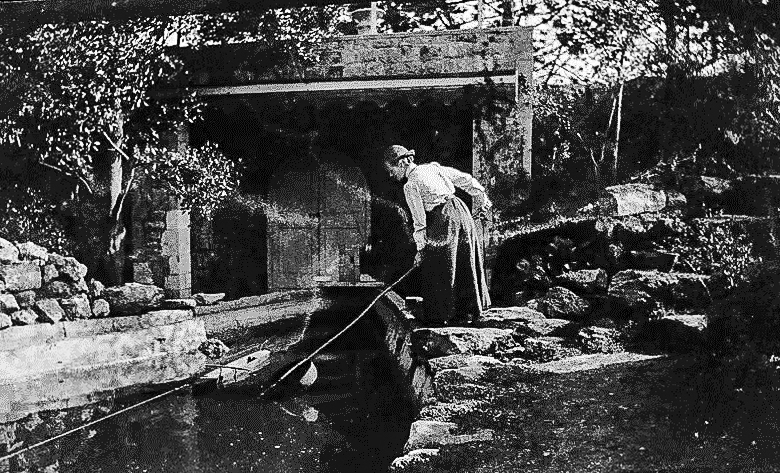
In Figure 3, Blanche is pictured holding one of the discs from the recording device, made by the Cambridge Scientific Instrument Company, which recorded the performance of the model boat in the ‘Lily Pond’ tank. As John Jeffries comments, the lily pond still exists (as of 2018) and ‘…astonishingly perhaps, models in reasonable condition have been recovered from the bottom in recent years’ (Jeffries, 2016, 2.4).
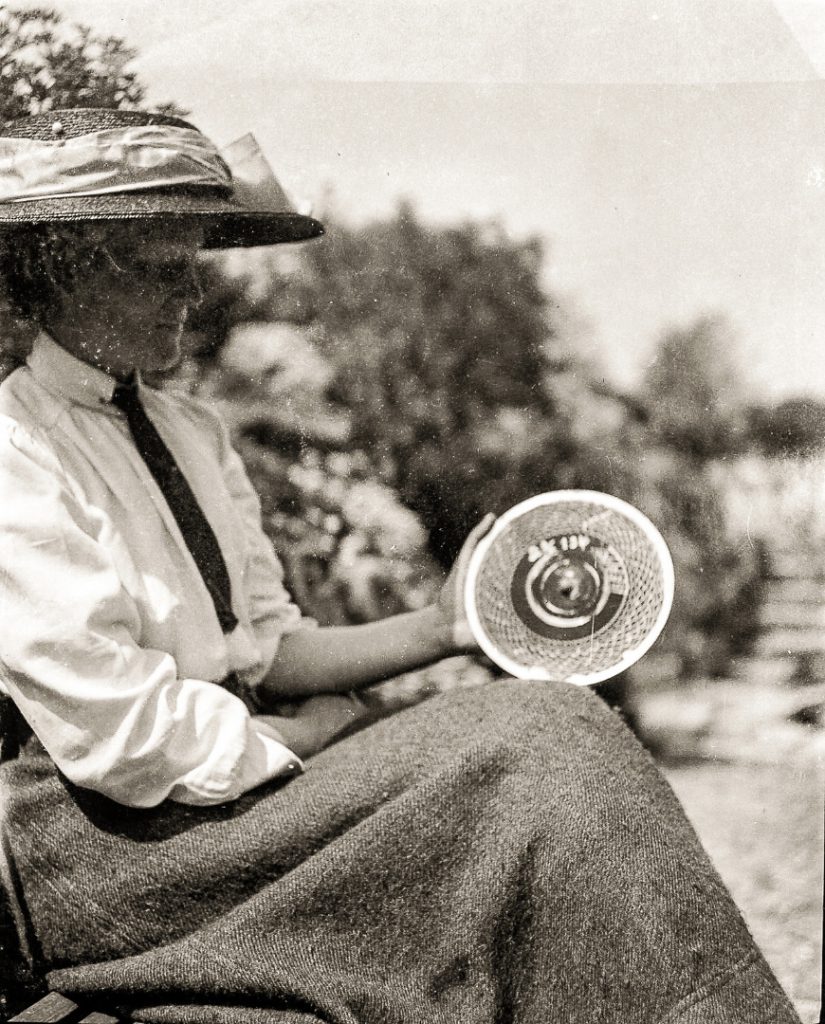
Two of the most notable pre-First World War boats, Mimi and Toutou, that appear in Blanche’s notebooks were built at Chiswick and supplied by Thornycroft to the Royal Navy for what the London Gazette called ‘The Tanganyika Naval Expedition’. The expedition was covered in 1922 within the pages of the National Geographic by one of the participants (Magee, 1922). Blanche worked on the testing of these boats with her father and may have attended the testing on the Thames. It is thought that the picture below (Figure 4) may show Blanche standing in the stern of Mimi. Toutou is tied up in the foreground and the picture was taken at Chiswick, during trials on the Thames. A further, if more indistinct image (see Figure 5) appears to show the same person aboard the boat at speed.
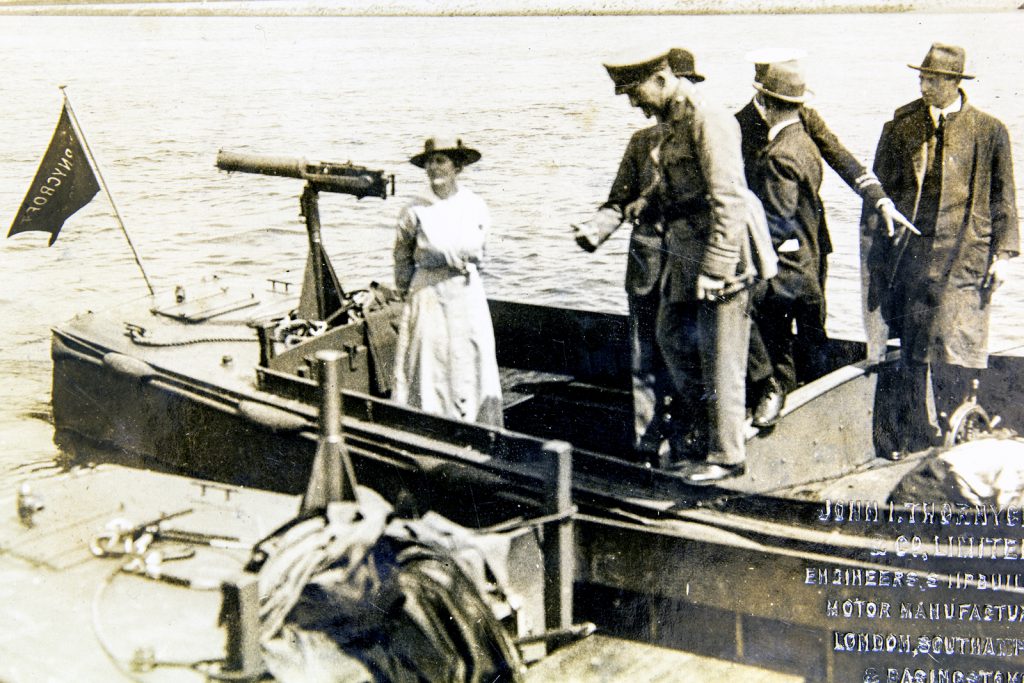

These boats were forty-foot Thorneycroft twin engine motor boats, originally ordered as seaplane tenders for the Greek Air Force. However, the needs of the Admiralty came first as the London Gazette reported:
In April 1915, a scheme was approved by the Admiralty for depriving the Germans of the command which they had hitherto held, by means of three small armed vessels, on Lake Tanganyika. The plan was to send out from England to Cape Town, and thence by rail, road and river to the Lake, two motor-boats of a speed and armament which would outclass those of the German vessels. The two boats, with a small Expeditionary Force under the command of Commander G. Spicer Simson, R.N., arrived at Cape Town towards the end of June. By December 23rd the ‘Mimi’ and the ‘Toutou,’ as the boats were named, had been successfully launched on the Lake, and three days later the first action was fought.
Although the use of the lily pond was successful as a way of collecting data for design, it was dependent on the vicissitudes of the weather which could mar the results. The need for more accurate data led the firm to investigate building a new test tank. The tank was constructed in another part of the family garden at The Old Battery in Bembridge to a design by the engineering company I.G. Mouchel[5] (see Figure 6). The first test was recorded by Blanche as taking place on 3-4 November 1911 (see Figure 7).
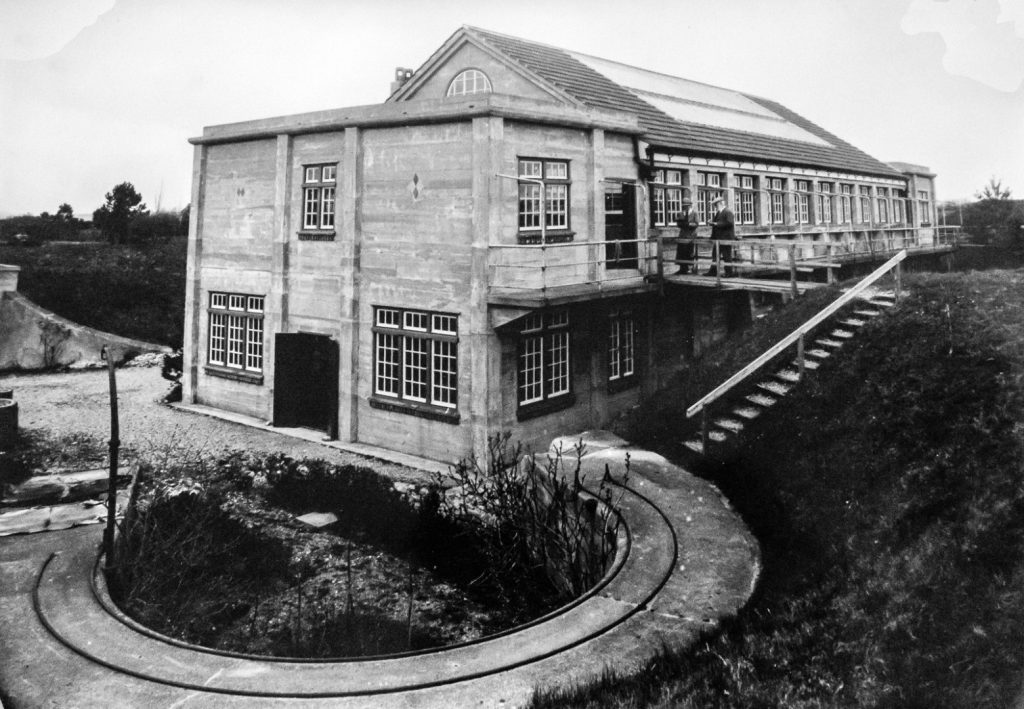

Beneath the working areas at each end of the tank and contained within the lower floor of the building were two workshops; one was for the carpenter who made and adapted the models whilst the other was used by a metal worker.
Kenneth Barnaby describes the operation of the tank in some detail (Barnaby, 1964). Historic England give the dimensions as 67 feet 6 inches long, 30 feet wide and 13 feet 9 inches deep. The tank operated using the ‘falling-weight principle’, with deep wells at each end, with a towing mechanism comprising a winding drum attached by a line to the model under test. The speed of the model was then measured by using a tuning fork to inscribe a sine wave trace on a carbon (smoke)-blackened disc attached to the winding drum. Barnaby noted that:
This simple equipment may sound a little out of date, but a tuning fork maintains its frequency, whereas more complicated electronic devices do, at times, give trouble. The strong acceleration also has an advantage, as it seems to break down laminar flow without the need for special turbulence stimulators.
The line ran from each weight to a pulley at the top of two towers at either end of the tank. Addition of mass to either of the weights controlled the speed of the pull. The towers, pulleys and pits are still extant, but the line is not. It seems that the model may have been attached to a bar slung on the line.
This method and the possibility that there were different bars for higher and lower speeds is alluded to in a letter from Blanche to John E Thornycroft written on 16 January 1931. With some models the centre of gravity, the height of the towing beam and the heavy pull required corrections to be made to achieve to the necessary settings.[6]
One of Blanche’s tasks was to try and improve the speed of the pull. Thornycroft were using the Cambridge Scientific Instrument Company to develop additional bars for the measurement process.[7] An undated photograph (see Figure 8) shows a model under test and is annotated in what appears to be Blanche’s handwriting – ‘90 mph EI 3 lbs measured 9 inches from the transom’. The speed referred to would have been arrived at by calculation from the scale speed and it is this type of work that was carried out by Blanche.
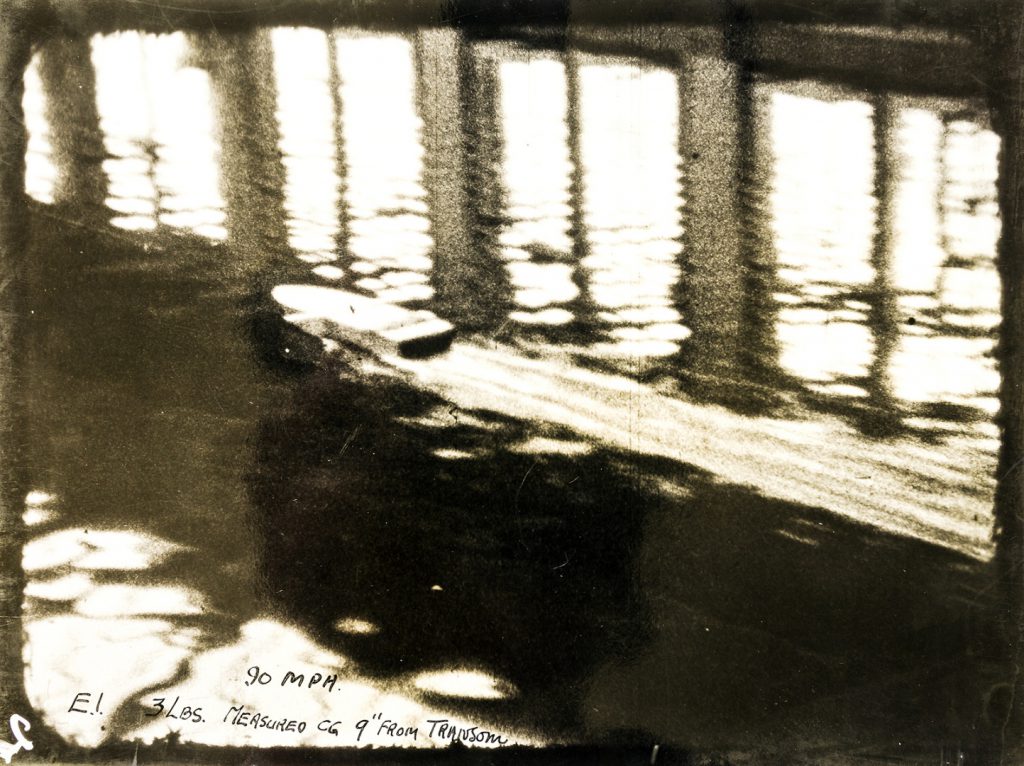
During the First World War (note Historic England) ‘…Sir John, assisted by his daughter Blanche, an Associate of the Institution of Naval Architects, did a considerable amount of work with his experimental tank and, among other things, established the resistance of the mooring-ropes of mines when inclined at different angles to the current.’[8] This work would also turn out to have a peacetime application.
A request in 1935 from The Western Union Telegraph Company to Sir John E Thornycroft illuminates further Blanche’s work during the First World War. They enquired whether he could furnish them with the results of the tests on the resistance of wire hawsers at different angles to the current. Apparently, though copies had been sent to both the Admiralty and the National Physical Laboratory, these had been lost. Sir John wrote to Blanche on 9 May 1935 asking if she could find her original notes. Blanche had replied supplying the data by the 21st of the same month enabling Sir John to write to Western Union enclosing it, stating:
I now send you two curves which have been plotted from the results of experiments carried out by my father, the late Sir John I. Thornycroft, in 1917. Miss Thornycroft, who acted as his assistant during the war period, has turned up the original notes of the experiments corresponding with the curves which were produced from them. The results were used by the Admiralty Department concerned at the time for mooring wires for mines etc. and were accepted as accurate.
The method of carrying out the trial was to suspend the wire below a ship model of known resistance at the different speeds, which was towed in the ordinary way. […] I trust that the information I am sending will be useful to you and am very glad to think that the time which was taken, (actually several months [sic] hard work during the war period) may prove useful in connection with peaceful operations.[9]
Blanche’s note book containing the tests results on wire hawsers shows that the experiments actually took place from May 1916 until January 1917, hence Sir John somewhat understates the amount of time and effort involved.[10] This reveals that Blanche was closely involved in the work of the tank at Bembridge.
Perhaps the most important work by Thornycroft’s during the war was in developing a peacetime design into a vessel that could be used for war. From the early forays into Olympic speed boats, John I. Thornycroft and Company were ideally placed to supply lightweight fast 40- and 55-foot torpedo boats, thus giving the Navy of the time the advantage of lightning raids that in the twenty-first century would be carried out by aircraft or missiles. A history of their development published by the company in 1918 states:
The very extensive use of mines made it extremely difficult for submarines and boats of considerable draught to approach the enemy bases, with the result that the smallest possible vessel with a great speed was again the obvious means of carrying the Whitehead torpedo to attack the enemy.
In order to keep the boats light and of minimum draft, they were built of wood, the earliest of them having only one torpedo as their armament, launched backwards from the stern of the boat. The method of attack was that the Coastal Motor Boats or CMBs would be carried to a point out of sight of, but close to, their target by a larger warship. The first 40-footers were capable of being slung in lifeboat davits on the mother ship. Having been launched by the larger warship, the CMBs raced into harbours and headed straight for their target ship, only firing their torpedo at what might be described as point-blank range. The CMB needed to get out of the way of the torpedo, hence a 180-degree turn was executed at high speed and a hasty return to the mother ship effected. The boats, whilst extremely fast, with speeds in excess of thirty knots, needed to be highly manoeuvrable and it was here that the careful testing, recording and calculation by Blanche Thornycroft prior to the first build in 1915 was vital. Their speed depended on the hull shape causing the boat to ‘plane’ meaning that the stern, being pushed deeper in the water as the speed increased, so that the bow rose, and over half the total length of the CMB lifted out of the water. This reduced the friction on the hull and made these boats extremely fast. However, the boat also had to be stable, a factor which could be compromised as the bow rose and it was here that the testing of the hull shape in model form was so important.
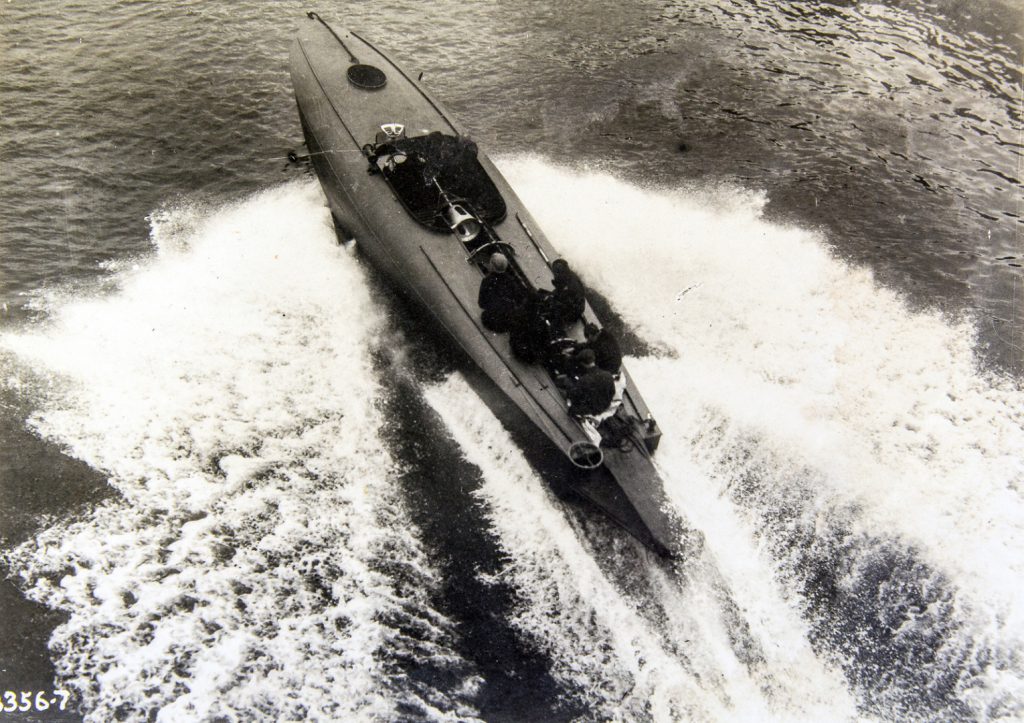
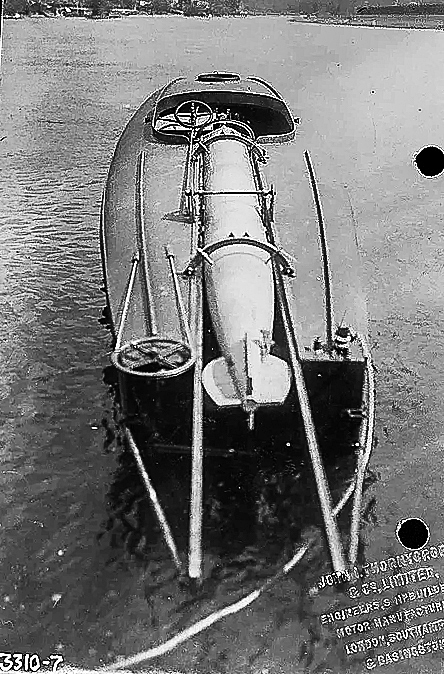
The CMBs were developed throughout the war. Blanche was recording tests on the later 55-foot boats in September 1917. These boats were used in raids on Zeebrugge and Ostend in 1918, and perhaps most famously in the attack on Kronstadt harbour against Bolshevik ships in 1919. Lt Cdr Agar commanding CMB4 was awarded the Victoria Cross for his role in the attack.[11]
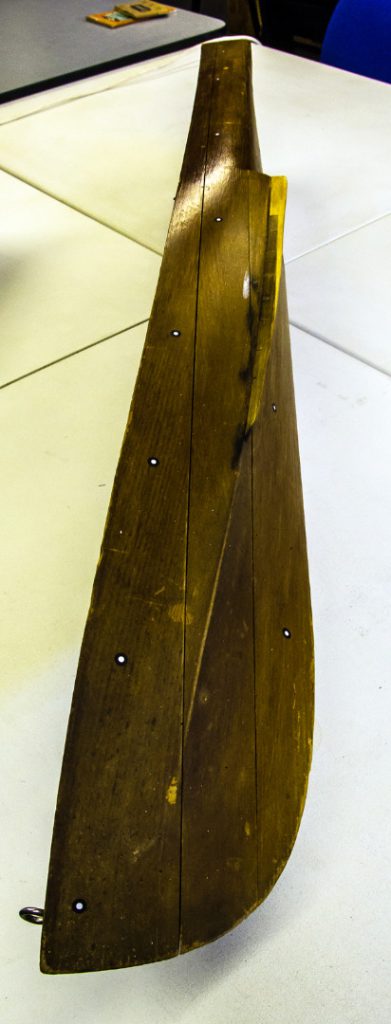
The original model CMB that Blanche tested is now in the care of the Classic Boat Museum, East Cowes. It measures nearly six feet long and it has been three-dimensionally scanned to enable a reconstruction of CMB4 to be undertaken at the National Shipbuilding College at Portsmouth. In this regard alone, the work Blanche did in the original testing of these craft is worthy of note.
The hidden daughter?
https://dx.doi.org/10.15180/1851009/005The Daily Post in January 1916 reported that Blanche ‘invented CMBs’ and she replied in trenchant fashion.
Miss Thornycroft writes as follows:
…This is quite incorrect. For some years before the war my father and brother developed a special form of hull, which would not only skim on the surface of the water when driven at high speed, but also had good seagoing qualities. Having assisted in model experiments for these boats, in 1915, when my father and brothers were unable to give sufficient time to it –I merely had charge of some further model experiments which they designed and supervised.[12]
This appears to the authors to be a modest summation of her contribution based on the archival evidence available. It is possible that it may indicate an example (as described by Cathleen Folker) of a daughter ‘…finding her identity through this care of their father and his business’. It might not be too presumptuous to suggest with Folker (2008, p 157), Gillis-Donovan and Maynihan-Bradt (1990, p 153) that Blanche was one of those women in a family company, who though they ‘…may not hold a formal role and tend to be invisible’, they often wield ‘unacknowledged power and influence in the family business’.[13] Blanche also seems here to be giving credence to Rodríguez-Modroño et al’s argument that women tended to hide their important roles in the family firm (Rodríguez-Modroño, Lina Gálvez-Muñoz and Astrid Agenjo-Calderón, 2015, p 2).
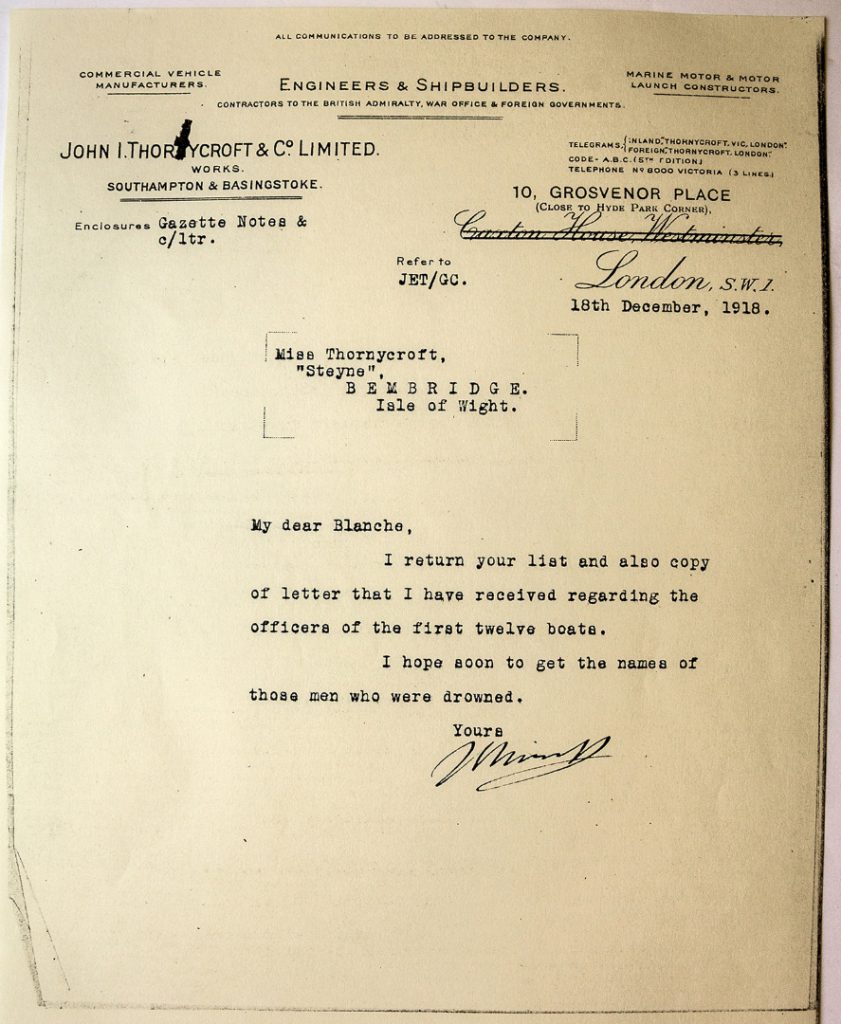
The letter from John E Thornycroft[14] pictured here, together with its enclosures is a response to a letter from Blanche, which has not survived. From the reply it can be deduced that Blanche asked which men were involved in the Zeebrugge and Ostend raids (April/May, 1918), and who survived. She seems to have been a naval architect who cared about the men who used the craft she had worked on.
Blanche also worked on the testing of the destroyers that might, in the hands of enemy countries, be used to combat the torpedo boats. HMS Hardy was built for the British Navy and completed by the Thornycroft Company in 1913, with Blanche working on the testing of the hull design, the features of which were common to the five Acasta Class Destroyers built by Thornycroft.
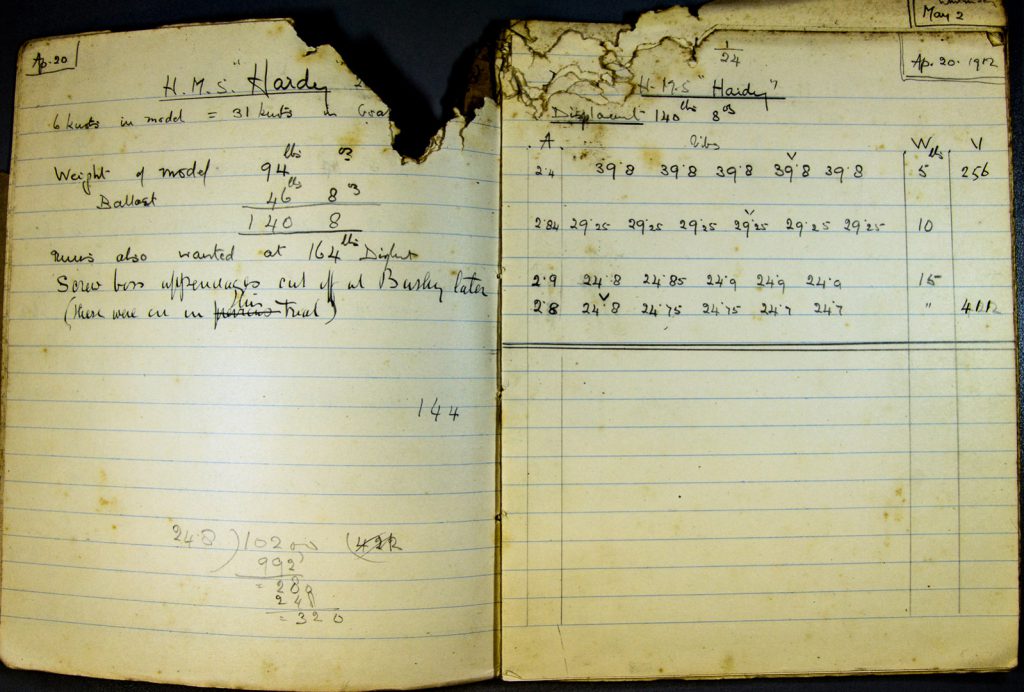
The Thornycroft Archive also contains a letter written by Blanche on 24 January 1916, which demonstrates her understanding of naval architecture as communicated to her brother John Edward Thornycroft. Her work consisted of drawing new curves to supplement earlier calculations under three different operating conditions – a wider stern, increased displacement and different centre of gravity.
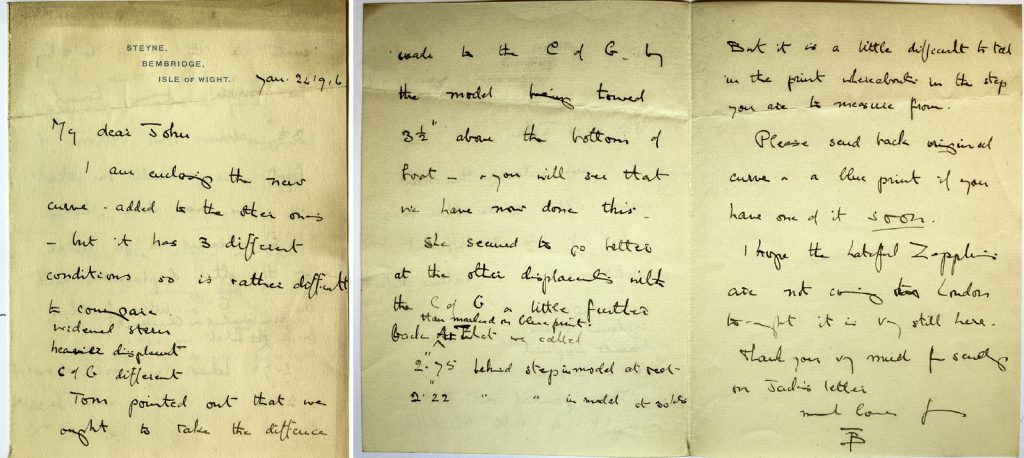
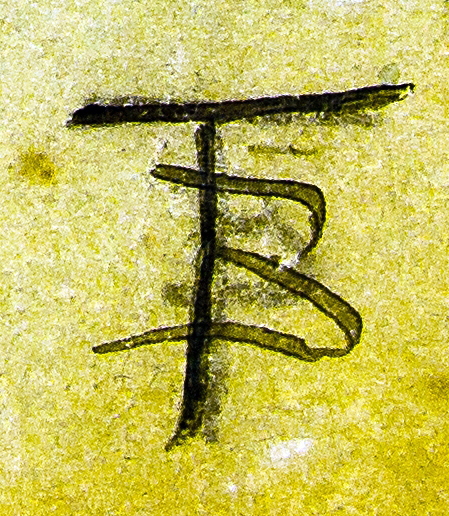
Membership of the Royal Institution of Naval Architects
https://dx.doi.org/10.15180/1851009/006Blanche’s position as an assistant to her father seems to have been informal in that she was not part of the published organisational structure of the corporate entity. However, there was external recognition, and validation of her role as an engineer. The professional body which ‘governed’ Naval Architecture was in 1919 known as the Institution of Naval Architects (INA). The admission of women into its ranks seems to have been prompted by the work done by women in the field of ship design during the First World War and in late 1918 a referendum was held amongst its members, which asked if women should be admitted. Sir Alfred Yarrow, Bart., Honorary Vice President of the Institution, is recorded as saying in 1919:
Some twenty five years ago I proposed that a lady should be admitted as a member of this Institution, but I got such a volley of abuse that I felt quite fortunate in getting out of the room with my life.
It might be thought that such a proposal in 1918, would again be greeted with chauvinistic scorn. However, the referendum, according to the Transactions, was ‘overwhelmingly in favour’ (INA Transactions, 1919, p 122) and the rule changes needed to admit women were proposed and carried.
The Annual General Meeting of the Institution of Naval Architects held on 9, 10 and 11 April 1919 added a significant sentence to its Constitution. What had read: ‘1. The Institution of Naval Architects shall consist of Five Classes, viz. Honorary Members, Member, Associate-Members, Associates, and Students’ (INA Transactions, 1918, p xxvi) from 1919 read: ‘1. The Institution of Naval Architects shall consist of Five Classes, viz. Honorary Members, Member, Associate-Members, Associates, and Students. Each Class shall be open alike to men and women’ (INA Transactions, 1919, p xxvi).
This change did not go un-noticed in the wider community of professionals. The British Journal of Nursing reported as follows:
The Institution of Naval Architects, at their resumed conference at the Society of Arts, elected their first three lady associates, following the decision to open their membership to ladies. […] Sir William Smith, who presided, said that the necessary alterations of the rules to allow the admission of women would require the sanction of the Privy Council.
(Anon, 1919,) British Journal of Nursing
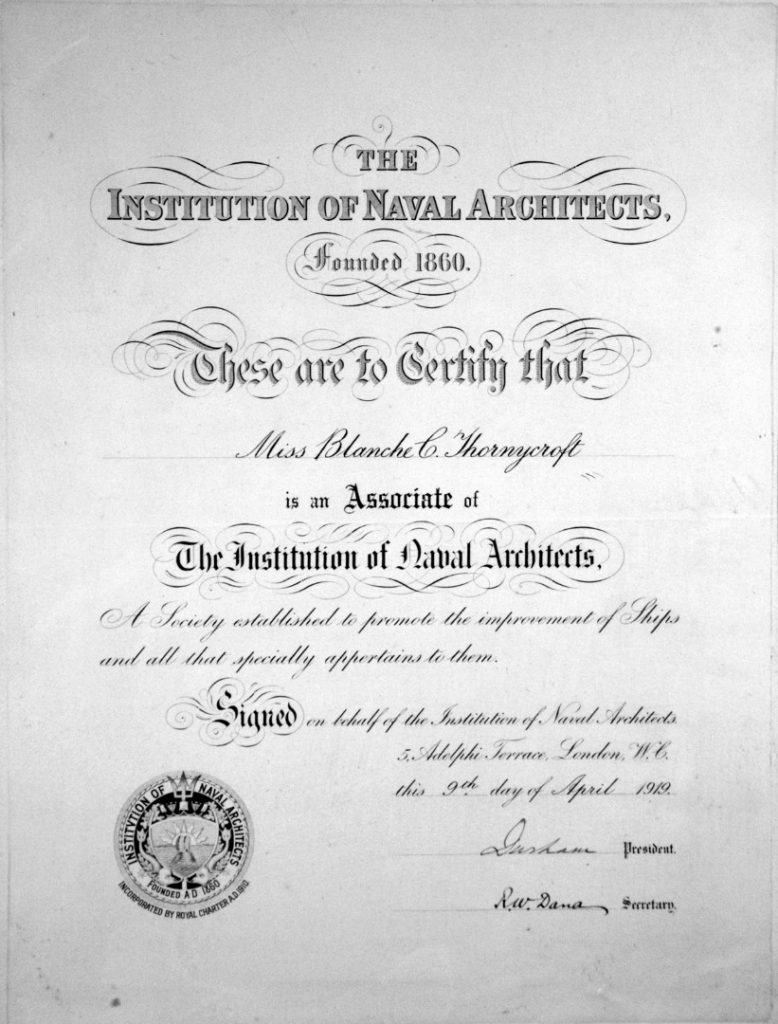
One of those three first female Associates was Blanche Thornycroft. In fact, the certificate of Associateship awarded to Blanche and held in the family collection is dated 9 April 1919, i.e. the first day of the AGM and thus before the Privy Council had agreed the change in the Byelaws. The Institution had, however ‘…sought the advice of solicitors in order to put this matter in strict legal shape’ (INA Transactions, 1919, p 122) hence presumably they had also checked that the Privy Council were not likely to object.
Two other women were also admitted in that year according to the roll of associate members. The Women’s Engineering Society’s journal The Woman Engineer in 1920 also reported: ‘The admission of Lady Parsons to membership of the N.E. Coast Institution of Engineers and Shipbuilders, and of Miss R Parsons, Miss Keary and Miss B. C. Thornycroft to the Institution of Naval Architects, are notable steps on the ladder the W.E.S. hope to see more and more women climb’ (Selby, 1920, p 28).
That Blanche was able to obtain membership of the guiding engineering institution tells us something about the perception of others regarding the role she played in Thornycroft’s design capability. The qualifications for an Associate according to the 1919 byelaws of the Institution were:
Admission of Associates.—Every Candidate for election into the Class of Associate shall, at the time of such election, be more than twenty-five years of age and shall be qualified either by profession or occupation, or by scientific or other attainments, to discuss with naval architects the qualities of a ship, or the construction, manufacture, or arrangement of some part or parts of a ship or her equipment, he shall submit a statement showing to the satisfaction of the Council his claim to be admitted as an Associate. This statement shall be signed by at least one Member, Associate-Member, or Associate of the Institution.
(Anon, 1919, Transactions of the Institution of Naval Architects, P xxviii)
Hence the women who were admitted in 1919 had to have demonstrated a clear professional understanding of Naval Architecture in theory and practice, and the granting of membership would have been conditional on this being acquired.
Sir John Isaac Thornycroft, Blanche’s father was delighted at his daughter’s admission to the Institution. He wrote a cheque for her membership fee, the receipt of which was acknowledged by R. W. Dana, Secretary to the Institution. In his letter he thanks Sir John for the cheque ‘…on behalf of Miss Thornycroft’ and continues, ‘I am sure that it must be a great satisfaction to you to feel that ladies can now join the Institution on the same terms as men, and I hope that as time goes on we may get a good addition to our role of membership from this source’.[15] Later, Sir John Isaac, in addressing a letter to Blanche who was at 27 Grosvenor Road, Westminster, adds ‘MINA’ to her name. In the letter he states: ‘I have just written to Dana to acknowledge your Diploma of Membership of the INA which has arrived in good condition.’[16] It seems almost churlish to point out that even as a proud father, he was not strictly correct. He should have designated Blanche an Assoc. Inst. I.N.A. according to the Byelaws of the Institution.
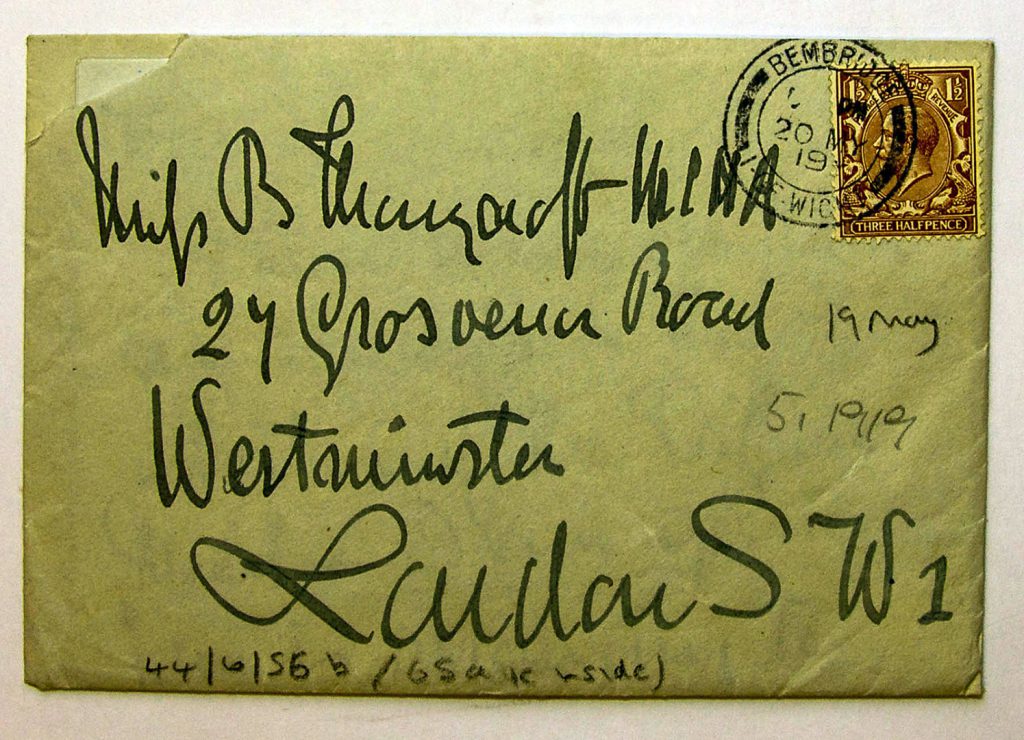
After the First World War there is ample archival evidence that Blanche Thornycroft continued to work within the family company. Sir John Isaac Thornycroft died in June 1928 and Sir John Edward Thornycroft, Blanche’s brother, took over the company.
However, it must be stressed that the Tom Thornycroft Archive is not an exhaustive company record. As with so many personal archives there are both gaps and arbitrary survivals. The period from 1921 to 1935 is particularly well represented in terms of letters to Blanche. However, the archive only contains the one earlier wartime letter written by her and quoted above. Hence what follows is a one-sided representation, an incomplete record from which conclusions can only be deduced.
In 1921, Mr W R Seward, based at the Thornycroft London office, sent to Bembridge railway station for the attention of Miss B Thornycroft, a model of a 32-foot Z/6 type launch for test. The letter asks her to run various tests in which the boat would be weighted differently. The work was urgent, for the launch would be changed depending on the results that she obtained. The archives hold a number of such letters including one from December 1923 in which Seward records a conversation he had had with Blanche at Olympia. The rest of the 1920s, as represented in the archives, seem to have been taken up with the testing of a fast RAF boat and a 64-foot fast life boat for the Royal National Lifeboat Institution.
The 1930s opened with the company testing vessels called Turkish Chasers, which were 90 feet long by 14 feet 6 inches wide. Blanche appears from the records to have continued work on these vessels until 1933. However, at around this time the operation of the Bembridge tank appears to have been causing some concern to Blanche and her brother John Edward. It seems that at high towing speeds there was a lack of consistency in the results. A letter written to Blanche from John on 31 October 1931 states: ‘I brought back with me the bar and its supports and am trying to arrange to get a new complete bit of apparatus for a higher speed…’[17]
A discussion of the Thornycroft testing equipment vis-à-vis the other model boat testing facilities in the country must have ensued, however, as in January 1932, John wrote to Blanche: ‘We have further information about the other tanks. The new one that the Farnborough people have made solely for seaplane work is not yet in operation and the Vickers tank can only tow at rather less speed than the Bushey one.’[18]
The large yacht Trenora[19] had been commissioned from the Thornycroft Company in 1933 by a wealthy British surgeon, Mr Gerald Stanley. The company also, at his request, provided an owner’s launch so that he could moor offshore and come to port in the smaller boat.
Blanche was working with K C Barnaby, the company’s Naval Architect, on testing at this period. One of the early letters in the archive from Barnaby, written on 20 November 1933, thanks Blanche for her early results on the Trenora owner’s launch and notes: ‘I will come straight to the tank on Thursday.’[20] The testing of the design produced what later seemed to be an excellent product. The launch appears to have been a great success with the owner who wrote a warm letter of congratulation to the company on 14 August 1934 stating that the design was ‘perfect for the uses I have for her’.[21]
From the evidence in the archive at Winchester, it appears that Barnaby worked quite closely with Blanche during the period 1933 to 1935. One of Barnaby’s letters to Blanche sheds an interesting light on the economic and business life of the period. He regrets having to cancel an appointment to work with her and comments that it is because:
‘…a man who fixed an appointment for last Thursday – and did not keep it – is now coming tomorrow, Tuesday. As people, who in these hard times can afford to order boats, are so few and far between, one cannot offend them, so I shall have to be on hand.’[22]
The economic stress also comes through in one of the last of Barnaby’s letters in the archive. On 14 January 1935, he writes to Blanche about the company’s hope to gain an order for a ‘rather special motor launch’ for the RAF and having given dimensions and proposed a model he says:
‘Would these dimensions be suitable, and would it be possible to run a model at a fairly early date? We are very anxious to make a good job of the boat if we get this order, as all of the recent boats have gone to Scott-Paine. I hope you are all well at Steyne.’[23]
It is at this point that the archival material on Blanche in the source repositories seem to dry up, but it is not clear if this is a reflection on a diminished workload. Blanche died in December 1950 at her home on the Isle of Wight.
Additional research has only uncovered two obituaries for Blanche and they are very contrasting records. The first is in the Journal of the Isle of Wight Natural History and Archaeological Society and has no reference to Blanche’s testing work. The other, which does mention her work, appeared in the Portsmouth Evening News on 1 January 1951 under the headline: ‘WOMAN’S ROLE IN R.N. SHIP DESIGN’ (Anon, 1951, p 7):
The death occurred suddenly on Saturday afternoon at her home; The Moorings. Bembridge, of Miss Blanche Coules Thornycroft, aged 76.
…Miss Thornycroft’s association with her father’s work as a ship designer was more intimate than is generally known. At Steyne, the family seat at Bembridge, the late Sir John I Thornycroft had specially built a large testing tank for his ship models. It was Miss Thornycroft’s duty to keep and work out the records obtained at these tests, and she thus had an early knowledge of many outstanding naval and power racing craft which the firm subsequently produced.
The wider role of women in engineering
https://dx.doi.org/10.15180/1851009/007To understand Blanche’s role within engineering it is instructive to consider the careers of the two other women invested in membership of INA at the same time. Rachel Parsons also came from an engineering family. She attended Newnham College, Cambridge and studied Mechanical Sciences for five terms, completing a preliminary and a qualifying examination for Part 1 of the Tripos. She was admitted to the same grade of membership of the Institution of Naval Architects on the same day as Blanche Thornycroft. Rachel’s father, Charles Parsons, was one of the key developers of the steam turbine and she and her brother Tommy participated in experiments at home. Tommy joined his father at Parsons Marine Steam Turbine Company in Newcastle-upon-Tyne but then went to war and was killed in 1918. While he had been away, Rachel was appointed an interim Director but her father refused to let her continue after the war causing a family rift. Rachel resigned and, determined to continue in engineering, and with the support of her mother, she founded the Women’s Engineering Society. She also had a leading role in founding and running Atalanta Ltd, a female engineering company which prided itself on the excellence and range of its products. Rachel’s status within the Parsons Marine Steam Turbine Company may well be that described in the literature by Collette Dumas (Dumas, 1992, pp 41–56); a daughter not considered for work in the family business until a crisis forced the issue and then only as a temporary stopgap.[24] Such crisis acceptance of women appears not to have been the case for Blanche, however, who continued her work for the Thornycroft Company much as before the war.
The third woman accepted as an Associate Member of the Institution of Naval Architects (INA) in April 1919 did not have a family ship building connection, but did complete the Cambridge Mechanical Engineering Tripos. Eily Keary (later Smith-Keary) had been appointed in June 1915 to the National Experimental Tank, Teddington, by the superintendent, G S Baker. Work at the tank had been proceeding on the design of seaplane floats and hulls. G H Millar, who had been in charge of the work, became a military pilot, hence Keary was appointed to replace him.
Baker worked closely with Keary and this collaboration produced ten Aeronautical Research Committee Reports and Memoranda between 1916 and 1923 (Koelbel, Jr. 1971, pp 66–68). Papers were also co-authored, beginning with the experimental testing of model seaplane floats (Baker and Keary, 1918a) and progressing to experiments with full size machines, the latter in conjunction with RAF personnel (Baker, Keary, Gundry and Hackforth 1918; Baker and Keary, 1918b). Baker and Keary then progressed to testing models of flying boat hulls described in two papers (Baker and Keary, 1918c). However, their next paper was an important departure from seaplanes both scientifically and in terms of gender equality.
The paper, ‘The effect of the longitudinal motion of a ship on its statical transverse stability’, again jointly with Baker, meant that Eily Keary was the first woman to co-author a paper read at the INA (Baker and Keary, 1918d). David Bailey notes: ‘Their paper was the first of its kind on the subject and anticipated the dangerous condition that can arise in high speed craft when a loll [sic] develops due to loss in transverse stability’ (Bailey, 1995, p 50). The importance of this paper may be gauged from the fact that the latest citation of it that the authors have thus far found is in 1988.
Later in 1918 Keary was promoted to the rank of junior assistant at the tank, and this appears to have been a more senior position than might be thought. Keary was still active at the tank into the 1930s and in 1925 she addressed the Liverpool Engineering Society. Her paper was entitled ‘Manoeuvring of Ships: Model Experiments of Rudder Forces under service conditions’ (Stanley, 2016, p 88).
‘In 1929 Miss Keary left to marry but…as Mrs Smith-Keary still found time to be involved for a few more years co-authoring two papers’ (Bailey, 1995, p 49). However, as yet only one has been found by the authors (Baker and Keary, 1930).
Conclusion
https://dx.doi.org/10.15180/1851009/008The case of Blanche Thornycroft is interesting for many reasons, not least her achievements in an era when women as professional engineers and mathematicians were rare. Primarily it shows how female family members might contribute to their business at a time when both the world and social mores were changing rapidly. The one commentator from the era whose written opinion of Blanche’s role within the company can be traced in the archives is Kenneth C Barnaby. Barnaby described Blanche as her father’s ‘…devoted assistant’ (Barnaby, 1964, p 92). Whilst the authors acknowledge the possibility of bias – Barnaby worked for the Thornycroft Company and the quotation comes from his official centennial history of the company – there is sufficient evidence in the archives to suggest that he held her in high regard.
Neither did the lack of a formal education seem to prevent Blanche from acquiring skills that enabled her to contribute to the business of designing ships. As discussed above, learning by doing within the family and the works was an already well-established method of producing an engineer. The premium apprentice (by payment) and normal apprentice system were based upon it. The difference in the case of Blanche Thornycroft is that she is an early example of her gender being taught by such means. Her father, John Isaac Thornycroft seems to have been a good mentor. The letters from her brother and employees of the firm examined by the authors defer to her in terms of the actual detailed mathematics of testing and one can infer that she was the expert upon whom they all relied.
Cathleen Folker’s notion of a daughter finding her raison d’être in caring for her father in the family firm (Folker, 2008, p 160) is interesting. Equally so, Gillis-Donovan and Moynihan-Bradt’s thesis that women who appear to those outside to be invisible in a family company, actually wield power and influence could also fit this case (Gillis-Donovan and Moynihan-Bradt, 1990, p 153). The archival evidence underpinning this paper suggests that Blanche Coules Thornycroft made a significant contribution to her family’s business, the wider field of naval engineering, and the position of women within the field.
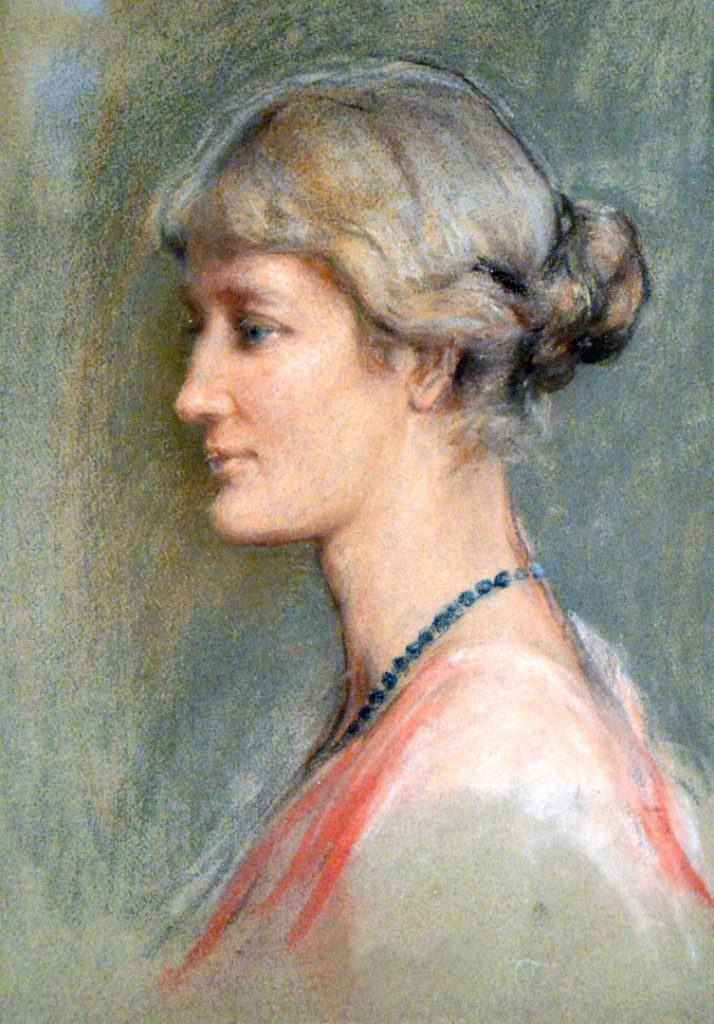
Acknowledgments
We would like to thank Hampshire Cultural Trust and in particular Ross Turl and Jo Bailey. John Jeffries, John Askham and all at the Classic Boat Museum at East Cowes were very supportive of our research. John Margetson and Hamo Thornycroft discussed the family with us, and the former showed us around the testing tank at Bembridge. We would also like to thank our referees for their comments. The AHRC provided the funding for the original research.
Tags
Footnotes
Back to text
Back to text
Back to text
Back to text
Back to text
Back to text
Back to text
Back to text
Back to text
Back to text
Back to text
Back to text
Back to text
Back to text
Back to text
Back to text
Back to text
Back to text
Back to text
Back to text
Back to text
Back to text
Back to text
Back to text






